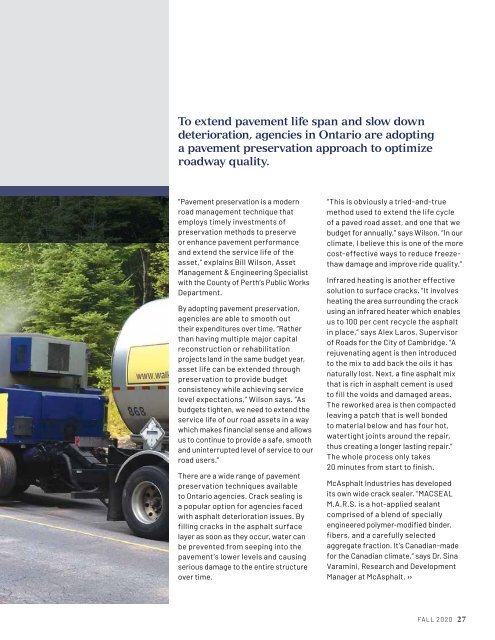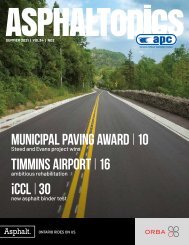ASPHALTopics | Fall 2020 | VOL 33 | NO 3
Create successful ePaper yourself
Turn your PDF publications into a flip-book with our unique Google optimized e-Paper software.
To extend pavement life span and slow down<br />
deterioration, agencies in Ontario are adopting<br />
a pavement preservation approach to optimize<br />
roadway quality.<br />
“Pavement preservation is a modern<br />
road management technique that<br />
employs timely investments of<br />
preservation methods to preserve<br />
or enhance pavement performance<br />
and extend the service life of the<br />
asset,” explains Bill Wilson, Asset<br />
Management & Engineering Specialist<br />
with the County of Perth’s Public Works<br />
Department.<br />
By adopting pavement preservation,<br />
agencies are able to smooth out<br />
their expenditures over time. “Rather<br />
than having multiple major capital<br />
reconstruction or rehabilitation<br />
projects land in the same budget year,<br />
asset life can be extended through<br />
preservation to provide budget<br />
consistency while achieving service<br />
level expectations,” Wilson says. “As<br />
budgets tighten, we need to extend the<br />
service life of our road assets in a way<br />
which makes financial sense and allows<br />
us to continue to provide a safe, smooth<br />
and uninterrupted level of service to our<br />
road users.”<br />
There are a wide range of pavement<br />
preservation techniques available<br />
to Ontario agencies. Crack sealing is<br />
a popular option for agencies faced<br />
with asphalt deterioration issues. By<br />
filling cracks in the asphalt surface<br />
layer as soon as they occur, water can<br />
be prevented from seeping into the<br />
pavement’s lower levels and causing<br />
serious damage to the entire structure<br />
over time.<br />
“This is obviously a tried-and-true<br />
method used to extend the life cycle<br />
of a paved road asset, and one that we<br />
budget for annually,” says Wilson. “In our<br />
climate, I believe this is one of the more<br />
cost-effective ways to reduce freezethaw<br />
damage and improve ride quality.”<br />
Infrared heating is another effective<br />
solution to surface cracks. “It involves<br />
heating the area surrounding the crack<br />
using an infrared heater which enables<br />
us to 100 per cent recycle the asphalt<br />
in place,” says Alex Laros, Supervisor<br />
of Roads for the City of Cambridge. “A<br />
rejuvenating agent is then introduced<br />
to the mix to add back the oils it has<br />
naturally lost. Next, a fine asphalt mix<br />
that is rich in asphalt cement is used<br />
to fill the voids and damaged areas.<br />
The reworked area is then compacted<br />
leaving a patch that is well bonded<br />
to material below and has four hot,<br />
watertight joints around the repair,<br />
thus creating a longer lasting repair.”<br />
The whole process only takes<br />
20 minutes from start to finish.<br />
McAsphalt Industries has developed<br />
its own wide crack sealer. “MACSEAL<br />
M.A.R.S. is a hot-applied sealant<br />
comprised of a blend of specially<br />
engineered polymer-modified binder,<br />
fibers, and a carefully selected<br />
aggregate fraction. It’s Canadian-made<br />
for the Canadian climate,” says Dr. Sina<br />
Varamini, Research and Development<br />
Manager at McAsphalt. ››<br />
FALL <strong>2020</strong> 27

















